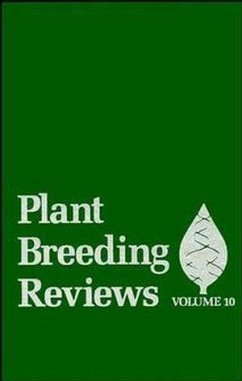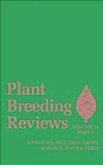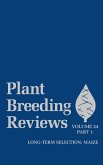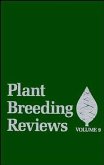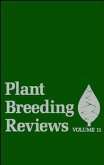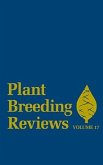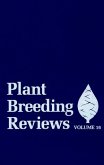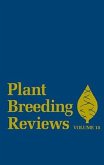Plant Breeding Reviews, Volume 10 (eBook, PDF)
Redaktion: Janick, Jules
314,99 €
314,99 €
inkl. MwSt.
Sofort per Download lieferbar

0 °P sammeln
314,99 €
Als Download kaufen

314,99 €
inkl. MwSt.
Sofort per Download lieferbar

0 °P sammeln
Jetzt verschenken
Alle Infos zum eBook verschenken
314,99 €
inkl. MwSt.
Sofort per Download lieferbar
Alle Infos zum eBook verschenken

0 °P sammeln
Plant Breeding Reviews, Volume 10 (eBook, PDF)
Redaktion: Janick, Jules
- Format: PDF
- Merkliste
- Auf die Merkliste
- Bewerten Bewerten
- Teilen
- Produkt teilen
- Produkterinnerung
- Produkterinnerung

Bitte loggen Sie sich zunächst in Ihr Kundenkonto ein oder registrieren Sie sich bei
bücher.de, um das eBook-Abo tolino select nutzen zu können.
Hier können Sie sich einloggen
Hier können Sie sich einloggen
Sie sind bereits eingeloggt. Klicken Sie auf 2. tolino select Abo, um fortzufahren.

Bitte loggen Sie sich zunächst in Ihr Kundenkonto ein oder registrieren Sie sich bei bücher.de, um das eBook-Abo tolino select nutzen zu können.
Part of a series which presents papers of topical interest relating to the breeding of plants important to agriculture and horticulture. Das E-Book Plant Breeding Reviews, Volume 10 wird angeboten von John Wiley & Sons und wurde mit folgenden Begriffen kategorisiert: Biowissenschaften, Botanik, Life Sciences, Plant Science
- Geräte: PC
- mit Kopierschutz
- eBook Hilfe
- Größe: 27.16MB
Andere Kunden interessierten sich auch für
![Plant Breeding Reviews, Volume 24, Part 2 (eBook, PDF) Plant Breeding Reviews, Volume 24, Part 2 (eBook, PDF)]() Plant Breeding Reviews, Volume 24, Part 2 (eBook, PDF)314,99 €
Plant Breeding Reviews, Volume 24, Part 2 (eBook, PDF)314,99 €![Plant Breeding Reviews, Volume 24, Part 1 (eBook, PDF) Plant Breeding Reviews, Volume 24, Part 1 (eBook, PDF)]() Plant Breeding Reviews, Volume 24, Part 1 (eBook, PDF)314,99 €
Plant Breeding Reviews, Volume 24, Part 1 (eBook, PDF)314,99 €![Plant Breeding Reviews, Volume 9 (eBook, PDF) Plant Breeding Reviews, Volume 9 (eBook, PDF)]() Plant Breeding Reviews, Volume 9 (eBook, PDF)314,99 €
Plant Breeding Reviews, Volume 9 (eBook, PDF)314,99 €![Plant Breeding Reviews, Volume 11 (eBook, PDF) Plant Breeding Reviews, Volume 11 (eBook, PDF)]() Plant Breeding Reviews, Volume 11 (eBook, PDF)314,99 €
Plant Breeding Reviews, Volume 11 (eBook, PDF)314,99 €![Plant Breeding Reviews, Volume 17 (eBook, PDF) Plant Breeding Reviews, Volume 17 (eBook, PDF)]() Plant Breeding Reviews, Volume 17 (eBook, PDF)314,99 €
Plant Breeding Reviews, Volume 17 (eBook, PDF)314,99 €![Plant Breeding Reviews, Volume 16 (eBook, PDF) Plant Breeding Reviews, Volume 16 (eBook, PDF)]() Plant Breeding Reviews, Volume 16 (eBook, PDF)314,99 €
Plant Breeding Reviews, Volume 16 (eBook, PDF)314,99 €![Plant Breeding Reviews, Volume 18 (eBook, PDF) Plant Breeding Reviews, Volume 18 (eBook, PDF)]() Plant Breeding Reviews, Volume 18 (eBook, PDF)314,99 €
Plant Breeding Reviews, Volume 18 (eBook, PDF)314,99 €-
-
-
Part of a series which presents papers of topical interest relating to the breeding of plants important to agriculture and horticulture. Das E-Book Plant Breeding Reviews, Volume 10 wird angeboten von John Wiley & Sons und wurde mit folgenden Begriffen kategorisiert: Biowissenschaften, Botanik, Life Sciences, Plant Science
Dieser Download kann aus rechtlichen Gründen nur mit Rechnungsadresse in A, B, BG, CY, CZ, D, DK, EW, E, FIN, F, GR, HR, H, IRL, I, LT, L, LR, M, NL, PL, P, R, S, SLO, SK ausgeliefert werden.
Produktdetails
- Produktdetails
- Verlag: John Wiley & Sons
- Seitenzahl: 392
- Erscheinungstermin: 6. Mai 2010
- Englisch
- ISBN-13: 9780470650004
- Artikelnr.: 38213743
- Verlag: John Wiley & Sons
- Seitenzahl: 392
- Erscheinungstermin: 6. Mai 2010
- Englisch
- ISBN-13: 9780470650004
- Artikelnr.: 38213743
- Herstellerkennzeichnung Die Herstellerinformationen sind derzeit nicht verfügbar.
Jules Janick is the James Troop Distinguished Professor of Horticulture at Purdue University in West Lafayette, IN, USA.
Contributors.
1 Dedication: Ernest Robert Sears (191D-1991) Geneticist par Excellence,
Cytogeneticist Extraordinaire, and a Good Man (George P. Redei).
2 Molecular Biology of Cytoplasmic Male Sterility (Mark E. Williams and
Charles S. Levings, III).
I. Introduction.
II. Plant Mitrochondria.
III. cms-T of Maize.
IV. Chimeric DNA Sequences Associated with CMS.
V. Correlation of the T-urf13 and pcf Genes with Male Sterility.
VI. Restorer Genes.
VII. Mechanisms of CMS.
VIII. Epilogue.
Literature Cited.
3 Plant Metabolism and Heterosis (David Rhodes, Grace C. Iu, Wen-Iu Yang,
and Yiannis Samaras).
I. Introduction.
II. Genetic Models of Heterosis.
III. The Metabolic Balance and Physiological Bottleneck Concepts of
Heterosis.
IV. The Metabolic Basis of Dominance.
V. Genetic and Metabolic Distance.
VI. Concluding Discussion.
Literature Cited.
4 Lethal Equivalents and Genetic Load (Neil O. Anderson, Peter D. Ascher,
and Richard E. Widmer).
I. Introduction.
II. Lethal Equivalents and Genetic Diversity.
III. Comparisons Between Formulae Using Multiple Inbred Generations.
IV. Lethal Equivalents as Predictive Tools for Inbred Line Development.
V. Implications.
Literature Cited.
5 Breeding for Heat Tolerance (Anthony E. Hall).
I. Introduction.
II. Sensitivity to Heat of Different Stages of Plant Development and Plant
Processes.
III. Characterizing Production Environments to Determine the Extent to
Which Heat is Reducing Yield.
IV. Genotype Differences in Heat Tolerance, Inheritance, and Associations
with Other Characters.
V. Selection Techniques and Breeding Methods.
VI. Progress in Breeding for Heat Tolerance and Conclusions.
Literature Cited.
6 Chromosome Manipulations and Genetic Analysis in Medicago (T. J. McCoy
and C. S. Echt).
1. Introduction.
II. Chromosome Manipulations in Medicago.
III. Genetic Analysis of Medicago.
IV. Summary.
Literature Cited.
7 Common Bean Improvement in the Tropics (Shree P. Singh).
I. Introduction.
II. History of Improvement in the Tropics.
III. Breeding Objectives and Strategies.
IV. Breeding Progress.
V. Testing.
VI. Conclusions and Prospects.
Literature Cited.
8 Breeding Cold Hardy Peaches and Nectarines (Richard E. C. Layne).
I. Introduction.
II. Morphological Responses to Low Temperatures.
III. Physiological Responses to Low Temperatures.
IV. Biochemical Responses to Low Temperatures.
V. Physical Responses to Low Temperatures.
VI. Germplasm Variability and Heritability.
VII. Selection for Cold Hardiness.
VIII. Screening Systems for Cold Hardiness.
IX. Summary and Conclusions.
Literature Cited.
9 Genetic Resistance in the Cucurbitaceae to Insects and Spider Mites (R. W
Robinson).
I. Introduction.
II. Sources of Resistance.
III. Testing Techniques.
IV. Resistance Mechanisms.
V. Inheritance of Resistance.
VI. Breeding for Insect Resistance.
Literature Cited.
Subject Index.
Cumulative Subject Index.
Cumulative Contributor Index.
1 Dedication: Ernest Robert Sears (191D-1991) Geneticist par Excellence,
Cytogeneticist Extraordinaire, and a Good Man (George P. Redei).
2 Molecular Biology of Cytoplasmic Male Sterility (Mark E. Williams and
Charles S. Levings, III).
I. Introduction.
II. Plant Mitrochondria.
III. cms-T of Maize.
IV. Chimeric DNA Sequences Associated with CMS.
V. Correlation of the T-urf13 and pcf Genes with Male Sterility.
VI. Restorer Genes.
VII. Mechanisms of CMS.
VIII. Epilogue.
Literature Cited.
3 Plant Metabolism and Heterosis (David Rhodes, Grace C. Iu, Wen-Iu Yang,
and Yiannis Samaras).
I. Introduction.
II. Genetic Models of Heterosis.
III. The Metabolic Balance and Physiological Bottleneck Concepts of
Heterosis.
IV. The Metabolic Basis of Dominance.
V. Genetic and Metabolic Distance.
VI. Concluding Discussion.
Literature Cited.
4 Lethal Equivalents and Genetic Load (Neil O. Anderson, Peter D. Ascher,
and Richard E. Widmer).
I. Introduction.
II. Lethal Equivalents and Genetic Diversity.
III. Comparisons Between Formulae Using Multiple Inbred Generations.
IV. Lethal Equivalents as Predictive Tools for Inbred Line Development.
V. Implications.
Literature Cited.
5 Breeding for Heat Tolerance (Anthony E. Hall).
I. Introduction.
II. Sensitivity to Heat of Different Stages of Plant Development and Plant
Processes.
III. Characterizing Production Environments to Determine the Extent to
Which Heat is Reducing Yield.
IV. Genotype Differences in Heat Tolerance, Inheritance, and Associations
with Other Characters.
V. Selection Techniques and Breeding Methods.
VI. Progress in Breeding for Heat Tolerance and Conclusions.
Literature Cited.
6 Chromosome Manipulations and Genetic Analysis in Medicago (T. J. McCoy
and C. S. Echt).
1. Introduction.
II. Chromosome Manipulations in Medicago.
III. Genetic Analysis of Medicago.
IV. Summary.
Literature Cited.
7 Common Bean Improvement in the Tropics (Shree P. Singh).
I. Introduction.
II. History of Improvement in the Tropics.
III. Breeding Objectives and Strategies.
IV. Breeding Progress.
V. Testing.
VI. Conclusions and Prospects.
Literature Cited.
8 Breeding Cold Hardy Peaches and Nectarines (Richard E. C. Layne).
I. Introduction.
II. Morphological Responses to Low Temperatures.
III. Physiological Responses to Low Temperatures.
IV. Biochemical Responses to Low Temperatures.
V. Physical Responses to Low Temperatures.
VI. Germplasm Variability and Heritability.
VII. Selection for Cold Hardiness.
VIII. Screening Systems for Cold Hardiness.
IX. Summary and Conclusions.
Literature Cited.
9 Genetic Resistance in the Cucurbitaceae to Insects and Spider Mites (R. W
Robinson).
I. Introduction.
II. Sources of Resistance.
III. Testing Techniques.
IV. Resistance Mechanisms.
V. Inheritance of Resistance.
VI. Breeding for Insect Resistance.
Literature Cited.
Subject Index.
Cumulative Subject Index.
Cumulative Contributor Index.
Contributors.
1 Dedication: Ernest Robert Sears (191D-1991) Geneticist par Excellence,
Cytogeneticist Extraordinaire, and a Good Man (George P. Redei).
2 Molecular Biology of Cytoplasmic Male Sterility (Mark E. Williams and
Charles S. Levings, III).
I. Introduction.
II. Plant Mitrochondria.
III. cms-T of Maize.
IV. Chimeric DNA Sequences Associated with CMS.
V. Correlation of the T-urf13 and pcf Genes with Male Sterility.
VI. Restorer Genes.
VII. Mechanisms of CMS.
VIII. Epilogue.
Literature Cited.
3 Plant Metabolism and Heterosis (David Rhodes, Grace C. Iu, Wen-Iu Yang,
and Yiannis Samaras).
I. Introduction.
II. Genetic Models of Heterosis.
III. The Metabolic Balance and Physiological Bottleneck Concepts of
Heterosis.
IV. The Metabolic Basis of Dominance.
V. Genetic and Metabolic Distance.
VI. Concluding Discussion.
Literature Cited.
4 Lethal Equivalents and Genetic Load (Neil O. Anderson, Peter D. Ascher,
and Richard E. Widmer).
I. Introduction.
II. Lethal Equivalents and Genetic Diversity.
III. Comparisons Between Formulae Using Multiple Inbred Generations.
IV. Lethal Equivalents as Predictive Tools for Inbred Line Development.
V. Implications.
Literature Cited.
5 Breeding for Heat Tolerance (Anthony E. Hall).
I. Introduction.
II. Sensitivity to Heat of Different Stages of Plant Development and Plant
Processes.
III. Characterizing Production Environments to Determine the Extent to
Which Heat is Reducing Yield.
IV. Genotype Differences in Heat Tolerance, Inheritance, and Associations
with Other Characters.
V. Selection Techniques and Breeding Methods.
VI. Progress in Breeding for Heat Tolerance and Conclusions.
Literature Cited.
6 Chromosome Manipulations and Genetic Analysis in Medicago (T. J. McCoy
and C. S. Echt).
1. Introduction.
II. Chromosome Manipulations in Medicago.
III. Genetic Analysis of Medicago.
IV. Summary.
Literature Cited.
7 Common Bean Improvement in the Tropics (Shree P. Singh).
I. Introduction.
II. History of Improvement in the Tropics.
III. Breeding Objectives and Strategies.
IV. Breeding Progress.
V. Testing.
VI. Conclusions and Prospects.
Literature Cited.
8 Breeding Cold Hardy Peaches and Nectarines (Richard E. C. Layne).
I. Introduction.
II. Morphological Responses to Low Temperatures.
III. Physiological Responses to Low Temperatures.
IV. Biochemical Responses to Low Temperatures.
V. Physical Responses to Low Temperatures.
VI. Germplasm Variability and Heritability.
VII. Selection for Cold Hardiness.
VIII. Screening Systems for Cold Hardiness.
IX. Summary and Conclusions.
Literature Cited.
9 Genetic Resistance in the Cucurbitaceae to Insects and Spider Mites (R. W
Robinson).
I. Introduction.
II. Sources of Resistance.
III. Testing Techniques.
IV. Resistance Mechanisms.
V. Inheritance of Resistance.
VI. Breeding for Insect Resistance.
Literature Cited.
Subject Index.
Cumulative Subject Index.
Cumulative Contributor Index.
1 Dedication: Ernest Robert Sears (191D-1991) Geneticist par Excellence,
Cytogeneticist Extraordinaire, and a Good Man (George P. Redei).
2 Molecular Biology of Cytoplasmic Male Sterility (Mark E. Williams and
Charles S. Levings, III).
I. Introduction.
II. Plant Mitrochondria.
III. cms-T of Maize.
IV. Chimeric DNA Sequences Associated with CMS.
V. Correlation of the T-urf13 and pcf Genes with Male Sterility.
VI. Restorer Genes.
VII. Mechanisms of CMS.
VIII. Epilogue.
Literature Cited.
3 Plant Metabolism and Heterosis (David Rhodes, Grace C. Iu, Wen-Iu Yang,
and Yiannis Samaras).
I. Introduction.
II. Genetic Models of Heterosis.
III. The Metabolic Balance and Physiological Bottleneck Concepts of
Heterosis.
IV. The Metabolic Basis of Dominance.
V. Genetic and Metabolic Distance.
VI. Concluding Discussion.
Literature Cited.
4 Lethal Equivalents and Genetic Load (Neil O. Anderson, Peter D. Ascher,
and Richard E. Widmer).
I. Introduction.
II. Lethal Equivalents and Genetic Diversity.
III. Comparisons Between Formulae Using Multiple Inbred Generations.
IV. Lethal Equivalents as Predictive Tools for Inbred Line Development.
V. Implications.
Literature Cited.
5 Breeding for Heat Tolerance (Anthony E. Hall).
I. Introduction.
II. Sensitivity to Heat of Different Stages of Plant Development and Plant
Processes.
III. Characterizing Production Environments to Determine the Extent to
Which Heat is Reducing Yield.
IV. Genotype Differences in Heat Tolerance, Inheritance, and Associations
with Other Characters.
V. Selection Techniques and Breeding Methods.
VI. Progress in Breeding for Heat Tolerance and Conclusions.
Literature Cited.
6 Chromosome Manipulations and Genetic Analysis in Medicago (T. J. McCoy
and C. S. Echt).
1. Introduction.
II. Chromosome Manipulations in Medicago.
III. Genetic Analysis of Medicago.
IV. Summary.
Literature Cited.
7 Common Bean Improvement in the Tropics (Shree P. Singh).
I. Introduction.
II. History of Improvement in the Tropics.
III. Breeding Objectives and Strategies.
IV. Breeding Progress.
V. Testing.
VI. Conclusions and Prospects.
Literature Cited.
8 Breeding Cold Hardy Peaches and Nectarines (Richard E. C. Layne).
I. Introduction.
II. Morphological Responses to Low Temperatures.
III. Physiological Responses to Low Temperatures.
IV. Biochemical Responses to Low Temperatures.
V. Physical Responses to Low Temperatures.
VI. Germplasm Variability and Heritability.
VII. Selection for Cold Hardiness.
VIII. Screening Systems for Cold Hardiness.
IX. Summary and Conclusions.
Literature Cited.
9 Genetic Resistance in the Cucurbitaceae to Insects and Spider Mites (R. W
Robinson).
I. Introduction.
II. Sources of Resistance.
III. Testing Techniques.
IV. Resistance Mechanisms.
V. Inheritance of Resistance.
VI. Breeding for Insect Resistance.
Literature Cited.
Subject Index.
Cumulative Subject Index.
Cumulative Contributor Index.
